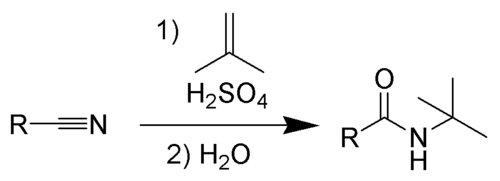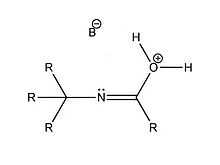Ritter reaction
The Ritter reaction is a chemical reaction that transforms a nitrile into an N-alkyl amide using various electrophilic alkylating reagents. The original reaction formed the alkylating agent using an alkene in the presence of a strong acid:[1][2][3]

Primary,[4] secondary,[5] tertiary,[6] and benzylic[7] alcohols, as well as tert-butyl acetate,[8] also successfully react with nitriles in the presence of strong acids to form amides via the Ritter reaction.
History
The Ritter reaction is named after John J. Ritter, an American chemist who received his Ph.D. from Columbia University. In 1948, P. Paul Minieri, Ritter's student, submitted work on the reaction as his Ph.D. thesis.[9] The reaction still has significance today due to its applicability and reproducibility of amides via stabilized carbocations.[1]
Reaction mechanism
The Ritter reaction proceeds by the electrophilic addition of either the carbenium ion 2 or covalent species[10][11] to the nitrile. The resulting nitrilium ion 3 is hydrolyzed by water to the desired amide 5.


Applications
The Ritter reaction is most useful in the formation of amides in which the nitrogen has a tertiary alkyl group. It is also used in industrial processes as it can be effectively scaled up from laboratory experiments to large-scale applications while maintaining high yield. Real world applications include Merck’s industrial-scale synthesis of anti-HIV drug Crixivan (indinavir);[12] the production of the falcipain-2 inhibitor PK 11195; the synthesis of the alkaloid aristotelone;[13] and synthesis of Amantadine, an antiviral and antiparkinsonian drug.[14] Other applications of the Ritter reaction include synthesis of dopamine receptor ligands[13] and production of amphetamine from allylbenzene.[15]
A problem with the Ritter reaction is the necessity of an extremely strong acid catalyst in order to produce the carbocation. This corrosive type of chemical poses an environmental hazard for chemical waste and safety risk for running the reaction itself. However, other methods have been proposed in order promote carbocation formation, including photosensitized electron transfer[16] or direct photolysis.[17]
References
- ↑ 1.0 1.1 Ritter, John J.; Minieri, P. Paul (1948). "A New Reaction of Nitriles. I. Amides from Alkenes and Mononitriles". Journal of the American Chemical Society 70 (12): 4045–8. doi:10.1021/ja01192a022. PMID 18105932.
- ↑ Ritter, John J.; Kalish, Joseph (1948). "A New Reaction of Nitriles. II. Synthesis of t-Carbinamines". Journal of the American Chemical Society 70 (12): 4048–50. doi:10.1021/ja01192a023. PMID 18105933.
- ↑ Krimen, L. I.; Cota, Donald J. (2011). "The Ritter Reaction". Organic Reactions. doi:10.1002/0471264180.or017.03. ISBN 0-471-26418-0.
- ↑ Lebedev, Mikhail Y.; Erman, Mark B. (2002). "Lower primary alkanols and their esters in a Ritter-type reaction with nitriles. An efficient method for obtaining N-primary-alkyl amides". Tetrahedron Letters 43 (8): 1397. doi:10.1016/S0040-4039(02)00057-6.
- ↑ Bishop, R.; In Comp. Org. Synth.; Trost, B.M., Fleming, I.; Eds.; Pergamon Press: New York, 1992; Vol. 6, 261-300. (Review)
- ↑ Ritter, J.J.; Kalish, J. (1964). "α,α-Dimethyl-β-phenethylamine". Org. Synth. 44: 44.; Coll. Vol. 5, p. 471
- ↑ Parris, C.L. (1962). "N-Benzylacrylamide". Org. Synth. 42: 16.; Coll. Vol. 5, p. 73
- ↑ Fernholz, H.; Schmidt, H. J. (1969). "Tert-Butyl Acetate as Alkylating Agent". Angewandte Chemie International Edition in English 8 (7): 521. doi:10.1002/anie.196905211.
- ↑ Ritter, JJ; Minieri, PP (1948). "A New Reaction of Nitriles. I. Amides from Alkenes and Mononitriles". Journal of the American Chemical Society 70 (12): 4045–8. doi:10.1021/ja01192a022. PMID 18105932.
- ↑ Booth, Brian L.; Jibodu, Kehinde O.; Proença, M. Fernanda J. R. P. (1983). "The chemistry of nitrilium salts. Part 2. The preparation of nitrilium trifluoromethanesulphonate salts and their reactions with some oxygen and sulphur nucleophiles". Journal of the Chemical Society, Perkin Transactions 1: 1067. doi:10.1039/P19830001067.
- ↑ García Martínez, A (1989). "An improved modification of ritter reaction". Tetrahedron Letters 30 (51): 581. doi:10.1016/S0040-4039(00)95260-2.
- ↑ Clayden, J.; Greeves, N.; Warren, S.; Wothers, P. Organic Chemistry; Oxford Press: New York, 2001.
- ↑ 13.0 13.1 Kurti, L.; Czako, B. (2005). Strategic Applications of Named in Organic Synthesis. Burlington, MA Elsevier Academic Press.
- ↑ Vardanyan, R.; Hruby, V.J. Synthesis of Essential Drugs, 1st Ed. Amsterdam: Elsevier, 2006; pp. 137
- ↑ Fujisawa and Deguchi, Chemical Abstracts, 52, 11965 (1958)
- ↑ Mattes, Susan L.; Farid, Samir (1980). "Photosensitized electron-transfer reactions of phenylacetylene". Journal of the Chemical Society, Chemical Communications (3): 126. doi:10.1039/C39800000126.
- ↑ Kropp, Paul J.; Poindexter, Graham S.; Pienta, Norbert J.; Hamilton, David C. (1976). "Photochemistry of alkyl halides. 4. 1-Norbornyl, 1-norbornylmethyl, 1- and 2-adamantyl, and 1-octyl bromides and iodides". Journal of the American Chemical Society 98 (25): 8135. doi:10.1021/ja00441a043.